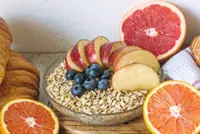Eating more slowly can be encouraged with structured, varied meals, eaten with cutlery. -— Photo: miodrag ignjatovic / Getty images, via ETX Daily Up
Wolfing down food too quickly is not without consequences for our health. Indeed, this eating habit is linked to an increased risk of obesity, cardiovascular disease and even certain types of cancer.
But do we really need to force ourselves to slow down, or could we simply structure our meals differently?
Researchers at Japan's Fujita Health University set out to investigate. Over a 12-week period, they monitored 41 adults, all members of the university staff, and gave them three types of meal.
These were either a slice of pizza warmed in the microwave, eaten by hand, or bentos consisting of rice, broccoli and chopped steak, eaten with chopsticks – sometimes starting with the vegetables, then sometimes saving them for last.
The scientists' aim was to find out whether the speed with which we eat depends more on the type of food we eat or the order in which we eat it.
Their findings, published in the journal Nutrients, speak for themselves. Bento meals resulted in significantly longer chewing times than pizza, regardless of whether the vegetables were eaten first or last.
On average, participants took 182 to 216 seconds longer to finish their bento.
In other words, it wasn't the order in which the food was eaten that slowed the pace, but rather the format of the meal.
But that's not all. The bentos also encouraged participants to chew more often and faster – without changing the number of bites.
This appears to have happened because a compartmentalized meal, served with utensils and composed of a variety of foods, naturally encourages people to slow down.
Clearly, a meal that requires a certain level of effort is a meal that can be enjoyed more slowly.
The scientists found no association between body mass index and meal duration. On the other hand, age and male sex seem to be associated with faster mealtimes.
Much more than our personal self-discipline, it could be the format of a meal – its composition, its presentation, the way it's eaten – that influences how quickly we eat it.
So, rather than forcing ourselves to slow down, it could be a question of giving ourselves the means to do so naturally.
In short, eating more slowly isn't (just) a matter of self-control: it's a choice that starts in the kitchen. It means foregoing quick, on-the-go meals and favoring structured, varied meals, eaten with cutlery.
This could well be one of the simplest and most effective tools to combat overeating.
Indeed, eating better could actually be a question of eating differently – taking your time, savoring each mouthful and sharing a moment with friends or family, for example.
Reframing mealtimes in this way could help foster a more conscious, more serene and healthier way of eating. – AFP Relaxnews





